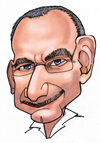How did The Dalton Gang and Jesse James help shape the ‘wild west’ image we see today? Were they bad people?
–Amy
? ? ?
Dear Amy,
Both the James-Younger and Dalton gangs were criminals who robbed banks and trains, and occasionally killed people who got in their way, so yes, you might call them bad men. As former Confederates who had rode with the mounted guerrilla bands of William Quantrill and “Bloody Bill” Anderson, Frank and Jesse James, Cole Younger and their cohorts got a lot of aiding and abetting from post-Civil War rebel sympathizers throughout Missouri for their depredations against the banks and railroads, but they were hardly robbing from the rich to give to the poor. The gang’s most ambitious gambit, robbing the First National Bank in Northfield, Minnesota, in 1876, ended in bloody disaster, with five dead. Yet the later Daltons sought to outdo that caper for sheer audacity, by robbing two banks at once in broad daylight—the First National and Condon banks in Coffeyville, Kansas, in 1892. They certainly outdid their predecessors in body count, with four of the gang—Bill Powers, Dick Broadwell, and Bob and Grat Dalton—and four townsfolk dead, along with Emmett Dalton, who was wounded and sentenced to life for second-degree murder. Of the two who escaped, Bill Dalton was gunned down by a posse in 1894 and Bill Doolin by Marshal Heck Thomas in 1896. ? ?Outlaws represented the “wildness” of the “wild west,” but those days were already on the wane when the Daltons hit Coffeyville. In all fairness, of the 15 children raised by James and Adeline Younger Dalton (who happened to be an aunt of the Youngers and related to the Jameses), 13 lived to adulthood and five went down the owlhoot trail, but the other eight went straight—one, Frank, even becoming a lawman, only to be gunned down by a bootlegger in 1888.
Sincerely,

Jon Guttman
Research Director
World History Group
More Questions at Ask Mr. History




